In this age of copyright, the pasticcio – in which pre-existing arias by various composers are assembled to make a ‘new’ work – is a somewhat discredited form, generally regarded with suspicion, viewed as a pragmatic response to the demand for novelty in the Baroque opera house, and which allowed star singers to show off their talents.
But, Irish National Opera’s production of Vivaldi’s Bajazet, the first opera by the composer to be staged at Royal Opera House, shows that pragmatism and vocal virtuosity do not preclude dramatic virtues, as director Adele Thomas and designer Molly O’Cathain brilliantly exploit the bravura and tenderness of Vivaldi’s score.
Bajazet was concocted for the 1735 Carnival season in Verona, where Vivaldi was both composer and impresario. Vivaldi opted to set Count Agostino Piovene’s Tamerlano – a popular libretto which was set 50 or so times during the eighteenth century, including (as adapted by Nicola Haym) by Handel in 1724 – presumably changing the title to differentiate his opera from others in the crowded field. He gathered his arias from works by Johann Adolf Hasse, Geminiano Giacomelli and Riccardo Broschi (brother of Carlo Broschi, better known as the castrato, Farinelli), drew others from his own earlier operas – including some, such as Semiramide, which are now lost – and then added a few news numbers and the largely accompagnato recitative.
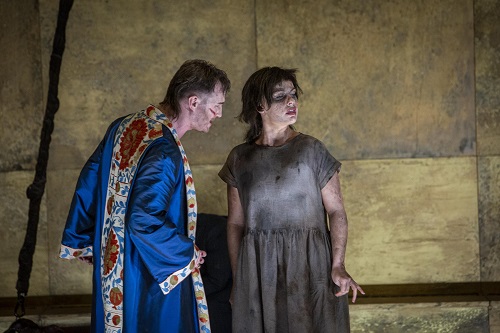
Bajazet confirms that Vivaldi was a careful, judicious curator. In a possibly snide dig at his musical rivals, he used his own arias for the noble, ‘sympathetic’ characters (Bajazet, Asteria, and Idaspe), while the music for the foreign invaders (Tamerlano, Andronico, and Irene) is by the Neapolitans. He demonstrates his commercial nous too: Irene’s Act 1 rage aria, ‘Qual guerriero al campo’, was a Farinelli favourite, and Vivaldi also borrowed arias that had been made famous by the contralto Vittoria Tesi, a perfect strategy for pulling in the punters.
The drama is a high-octane soap opera featuring sexual desire, deceit, torture and suicide. The Turkish emperor, Bajazet, has been defeated in battle by the ruthless Tartar shepherd-warrior, Tamerlano. The latter is smitten by the beauty of Bajazet’s imprisoned daughter, Asteria, and commands his ally, the Greek prince Andronico (who loves Asteria), to encourage her to accept advances, promising in return to free Bajazet and gift Andronico the hand of his own betrothed, the Trebizondian princess Irene. Asteria is enraged by what she considers Andronico’s perfidy. She determines to marry Tamerlano but then murder him on their wedding night – a plan not divulged to her distraught father who accuses her of betraying her nation. Learning of her own rejection, Irene assumes the guise of her servant and sets about disentangling the web of deception in her favour.
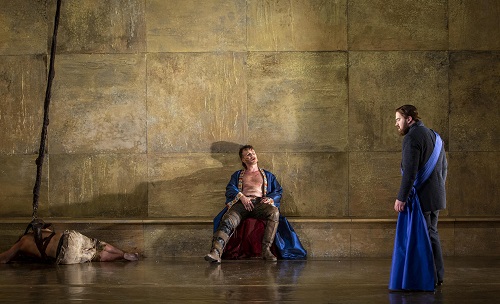
Thomas adopts a muscular approach to the unadulterated bravura, the riotous drama sometimes bordering on the unhinged. She explains that the pandemic has ‘worked its way into the DNA of the show’, but fortunately this does not mean yet more of those ubiquitous hand-sanitiser and social distancing gags – rather, it’s the claustrophobic emotional intensity of extended lockdowns that Thomas sees reflected in Bajazet: ‘It streams along like a panic attack, its characters are bundles of frayed nerves. They are all of them in their own way prisoners, locked in together in a near hysterical state of living trauma.’
O’Cathain’s stark, abstract set is an apt representation of this emotional alienation. Thomas has chosen to place the action in Bajazet’s own home, arguing convincingly that ‘Timur’s cuckooing of Bajazet’s ancestral home … [is] disturbing and intrusive: a physical and psychological violation’. The Turkish palace becomes a prison, the tarnished gold, light-flecked walls of which combine with the cobalt and indigo costumes to evoke a Mediterranean mood and hint at an imperial elegance now crushed by Tamerlano’s psychopathic cruelty. From a circular hole in the ceiling of the box set protrudes a giant hook, from which dangles a harness, in which the imprisoned Bajazet is bound.
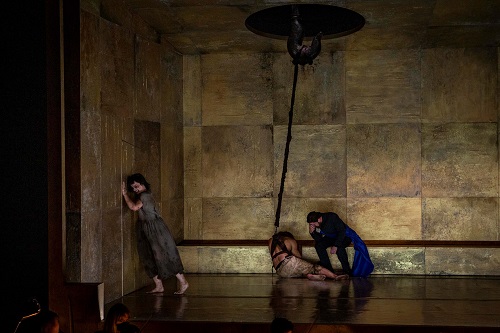
Within the bare walls, Thomas keeps the energy charge high and the electric tension fizzing, though the noisy door-hammering, wall-thumping – Bajazet even head-butts the wall during one of his arias! – and incessant dashing to and fro is a bit wearying after a while. There’s a playfulness too, though, as Thomas exploits the caricatures, and mostly she keeps things droll rather than dippy, though Andronico’s vaudeville-style antics in Act 3, as he shoves his head back and forth through the closed curtain, overstep the bounds. The da capos are not just ornamented extravagantly but also, at times, dramatically transformed, with various degrees of persuasiveness – I found Irene’s Act 2 volte face from poignant eloquence, when she first admires Asteria’s resolve, to haughty bad-temperedness when she repeats such sentiments, difficult to square with the music.
Bare-chested, war-wounded and power-crazed, countertenor James Laing compellingly captures the dangerous narcissism, unpredictable explosiveness and sheer nastiness of the brutal tyrant, Tamerlano. His splint-clamped leg is a powerful symbol of his damaged psyche, causing him to lurch and stumble with uncontrolled recklessness, as he mocks and manhandles his enemies, and jives with ghastly ungainliness. He exults in his own vulgarity, urinating on his suffering captive and fondling the alarmed Andronico. At times his inner poison manifests itself in a writhing pain that fells him, soothed only by the ministrations of the morphine-wielding, Idaspe (Bajazet’s confidante). Laing sings with colour and character, not afraid to take risks, and equally comfortable at the bottom and top – and when negotiating huge leaps between them, as in Act 1’s furious ‘In sì torbida procella’ and his scorching denunciation of Asteria in Act 3, ‘Barbaro traditor’, both of which were stunningly explosive.
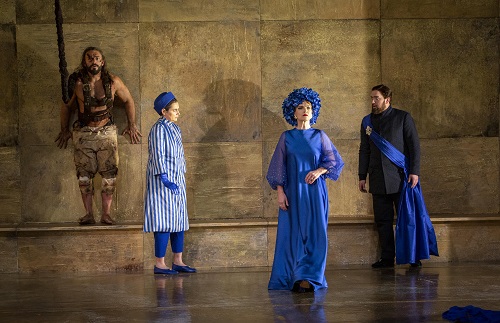
Mezzo-soprano Niamh O’Sullivan sings with touching eloquence, the lovely darkness of her voice making tangible Asteria’s deep, inner feelings, though a little less hysterical wall-slapping might have imbued her character with even greater tragic dignity. Claire Booth is encouraged to take Irene’s emotionalism to extremes and while she spins through Broschi’s dizzying ‘Qual guerriero in campo armato’ with courage and aplomb the results are inevitably a bit squally at times. I’d have liked to have heard a bit more of Booth’s more soothing lyricism which, when it was exploited, effectively cooled the temperature, calmed the clamour and encouraged identification with the spurned princess’s suffering.
Bass-baritone Gianluca Margheri is a rather one-dimensional Bajazet, but with his leonine locks and tortured intensity he’s a persuasively distraught patriarch, noble and earnest in his accompanied recitative, ‘Odi, perfida’, when he despairs at his daughter’s treachery. Margheri coped well with the high-lying passages and with the coloratura of his rage aria, though occasionally was prone to semi-shout in conveying Bajazet’s fury and frustration. As the rather weak-willed Andronico, counter-tenor Eric Jurenas impressed in the eloquent aria of disappointment and resignation with which he closes Act 1, and he easily negotiated the large vocal range required by the role. But, the silly business in Act 3 led him to eschew the control of line and tone that he’d demonstrated earlier. Aoife Miskelly was poised in the small role of Idaspe, her coloratura crisp, her presence bringing a welcome stability to the dramatic upheavals.
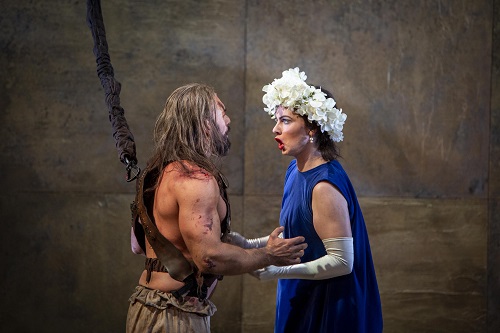
The playing of the ten-strong Irish Baroque Orchestra was an absolute joy. First violinist Julia Kuhn relished the beauties of Vivaldi’s string writing, and the two natural horns were brilliantly bright and punchy. The arias don’t indulge in complex instrumental counterpoint, and often the voice is accompanied by just a single line or unison. Leading from the harpsichord, with unfussy gesture and considerable discernment, Peter Whelan shaped the instrumental commentary superbly, especially in the quieter moments and accompanied recitatives – in the latter, lutenist Sergio Bucheli found myriad nuances and meanings.
For the second time this week, a Baroque opera at the Royal Opera House ended with a directorial twist, Thomas denying this Tamerlano the sympathy that his last-minute softening of heart might have inspired. On this occasion, one couldn’t help but feel the odious psychopath got his just deserts.
Bajazet continues at the Royal Opera House until 12th February.
Claire Seymour
Bajazet – Gianluca Margheri, Tamerlano – James Laing, Asteria – Niamh O’Sullivan, Andronicus – Eric Jurenas, Irene – Claire Booth, Idaspe – Aoife Miskelly, Director – Adele Thomas, Conductor – Peter Whelan, Associate director – Emma Woods, Set and costume designer – Molly O’Cathain, Lighting designer – Sinéad Wallace, Fight director – Kev McCurdy, Irish Baroque Orchestra.
Irish National Opera at the Linbury Theatre, Royal Opera House, Covent Garden, London; Saturday 5th February 2022.
ABOVE: Gianluca Margheri (Bajazet), Eric Jurenas (Andronico), Niamh O’Sullivan (Asteria) and Aoife Miskelly (Idaspe) (c) Kip Carroll